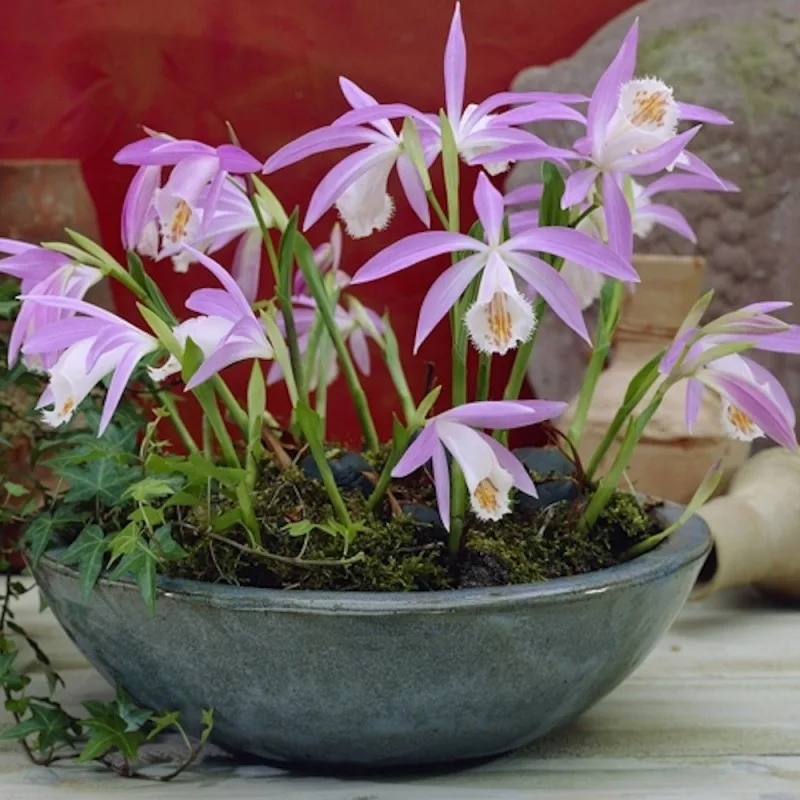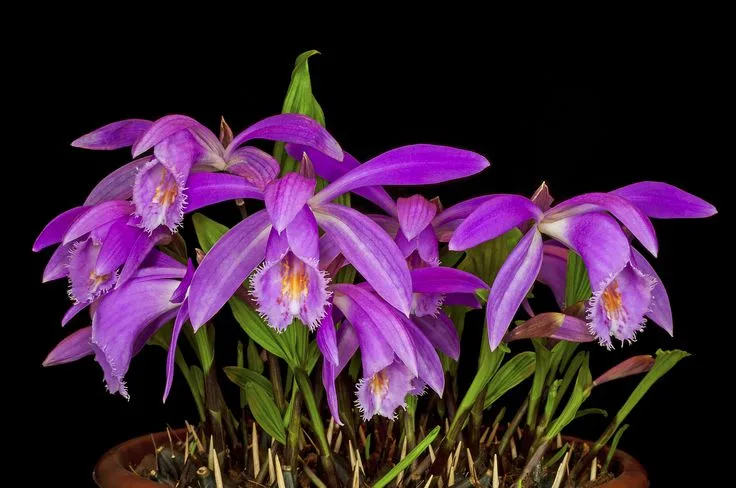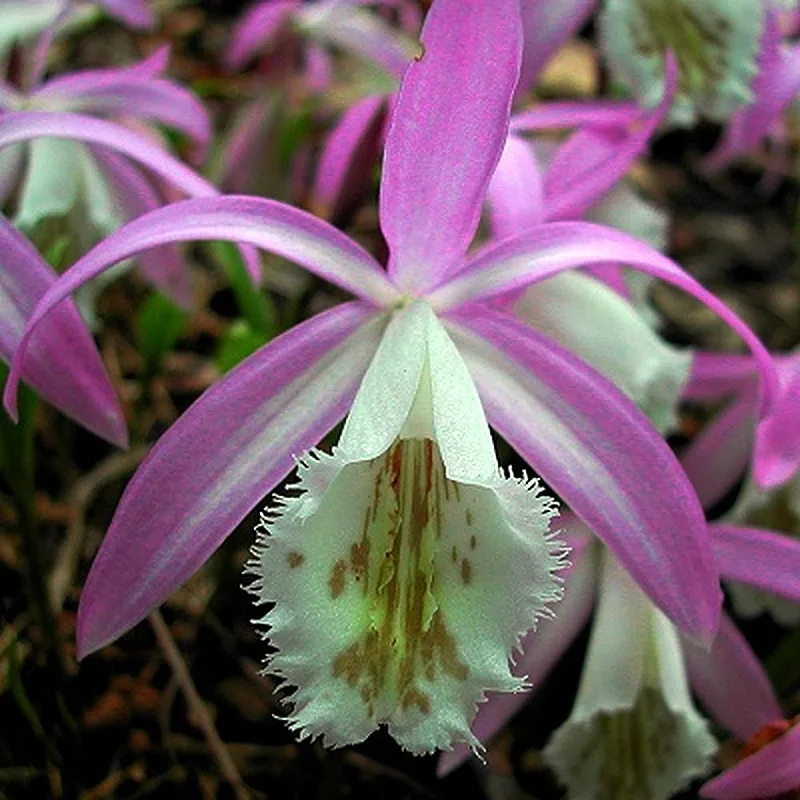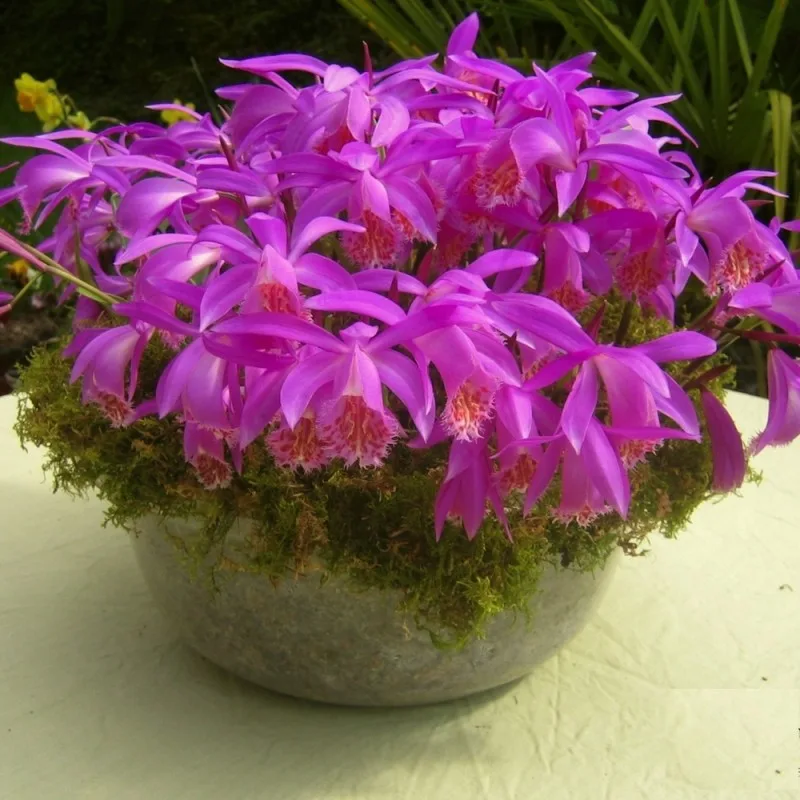index
Presentation
The peacock orchid (Pleione formosana), native to the subtropical forests of East Asia, is a true masterpiece of nature. Its exuberant flowers, reminiscent of the beauty of a peacock in full splendor, make it a coveted choice for orchid enthusiasts. With delicate leaves and pseudobulbs that store nutrients, Pleione formosana reveals a unique exuberance during its flowering season, creating a spectacle of colors and shapes in any garden.
The Meaning of the Peacock Orchid
In addition to its visual beauty, the peacock orchid carries with it enchanting symbolic meanings. Its flower, associated with elegance and exoticism, symbolizes delicacy in the midst of grandeur. In Eastern culture, it is considered a symbol of good luck and harmony. Growing this orchid is not just an aesthetic experience, but a celebration of the natural elegance that flourishes in lush and delicate environments.
| Common Name | Peacock orchid |
|---|---|
| Botanical Name | Pleione formosana |
| Family | Orchidaceae |
| Type of Plant | Terrestrial orchid |
| Adult size | Small to medium |
| Solar Exhibition | Partial to full sun shading |
| Soil Type | Well-drained soil, rich in organic matter |
| Soil pH | Slightly acidic to neutral |
| Flowering Season | Spring to summer |
| Color of Flowers | Various, including shades of purple and pink |
| Asia, especially Taiwan and China | |
| Toxicity | Not reported |

How to Care for the Peacock Orchid
Light
The peacock orchid flourishes best in places with partial shade, where it receives filtered light. Avoid direct exposure to strong sunlight, as this can cause damage to the delicate leaves and flowers. Finding the perfect balance of light is essential for its exuberant flowering.
Soil
Choose a well-drained soil rich in organic matter for your peacock orchid. The ideal substrate allows water to drain off easily, preventing accumulation and root problems. Specific mixtures for orchids are recommended to meet the specific needs of this plant.
Water
Watering the peacock orchid should be moderate. Avoid soaking the soil, but keep it evenly moist during the period of active growth. Reduce watering during the dormant period. The water used should be of good quality, without excess minerals.
Temperature and Humidity
These orchids appreciate environments with moderate to warm temperatures during the day and a gentle drop at night. Keep the humidity at around 50-60%. Adequate ventilation is crucial to avoid the build-up of excessive humidity.
Fertilization
Fertilizing is vital to the success of the peacock orchid. Use a balanced fertilizer specifically for orchids during the period of active growth. Reduce the frequency during the dormant period. Follow the manufacturer’s instructions to avoid excesses that could harm the plant.
By following these guidelines carefully, you will provide a suitable environment for the peacock orchid to thrive, displaying its unique beauty with every bloom.
How to make peacock orchid cuttings
Growing peacock orchid seedlings is a fascinating and rewarding process. Start by selecting healthy pseudobulbs and vigorous shoots. Carefully separate the seedling, ensuring that each portion has roots. Plant the seedlings in orchid substrate, keeping them slightly moist. Soon you will have new plants ready to bloom.

How to Plant The Peacock Orchid
Proper planting is crucial to the success of the peacock orchid. Choose a pot or planting site with good drainage. Transplant the seedlings, burying them lightly in the substrate. Avoid watering immediately; allow the seedlings to adjust to their new environment. After a few days, resume watering in moderation. This initial care will lay a solid foundation for the healthy growth of your orchid.
Most Common Pests and DiseasesMost Common Pests and Diseases
When caring for the peacock orchid, it is crucial to be aware of the challenges that can arise. Some common pests and diseases include:
- Bugs: Insects that feed on the sap, causing damage to the leaves.
- Mites: Tiny arachnids that can cause spots on leaves.
- Root rot: The result of excess moisture, leading to root rot.
- Leaf spots: A fungal problem that manifests itself as spots on the leaves.
Common Problems and Their Solutions
Bugs:
- Solution: Remove manually or use a soap and water solution.
Mites:
- Solution: Increase the humidity around the plant and use neem oil.
Root Rot:
- Solution: Improve soil drainage and reduce watering frequency.
Leaf spots:Leaf spots:
- Solution: Remove the affected leaves and apply an appropriate fungicide.
Keeping an eye out for these early signs and implementing effective solutions will ensure the lasting health of your peacock orchid, allowing it to flourish to the full.

Curiosities and Myths
In this section, we’ll delve into the fascinating peculiarities and debunk some myths surrounding the peacock orchid.
Curiosities
1. Underground flowering:
The peacock orchid, in its natural habitat, has the unique characteristic of flowering underground. Its flowers emerge from the ground, adding a magical touch to its life cycle.
2. Pollination strategies:
To attract pollinators, the orchid imitates the scent of a female wasp. The males, fooled by the scent, try to mate with the flowers, promoting pollination.
3. Resilience to Low Temperatures:
Unlike many tropical orchids, Pleione formosana is surprisingly cold-resistant, being able to withstand harsh winters.
Myths Debunked:
1. Peacock Orchid Attracts Peacocks:
Myth Debunked: Despite its name, the orchid is not related to peacocks. The name comes from the visual resemblance of its flowers to the feathers of a peacock.
2. The Peacock Orchid is Resistant to Everything:
Myth Debunked: Although resistant, this orchid still requires specific care. Ignoring its needs can lead to health problems, showing that even robust plants require proper attention.
By uncovering these curiosities and debunking myths, the journey of cultivating the peacock orchid becomes an enriching experience, full of fascinating nuances.

Conclusion
As we explore the care, challenges and curiosities surrounding the peacock orchid (Pleione formosana), we realize that cultivating this species goes beyond simple gardening; it is an enriching experience. From its unique ability to bloom underground to its clever pollination strategies, the peacock orchid proves to be a masterpiece of nature, surprising and delighting with every life cycle.
By debunking myths, we’ve learned that even a hardy plant like the peacock orchid requires specific care to thrive. Attention to light, humidity and pest prevention are essential. Growing this orchid is more than a hobby; it’s a commitment to preserving the unique beauty that nature offers us. May each blossom be a reminder of the dedicated care and admiration for the subtle exuberance of the Peacock Orchid.
Frequently Asked Questions
How to plant the peacock orchid?
Planting the peacock orchid is a delicate process and crucial for its healthy establishment. Choose a pot or planting site with good drainage, which is essential to avoid root problems. Transplant the seedlings or the orchids themselves, ensuring that the pseudobulbs are slightly buried in the substrate. Avoid watering immediately after planting to allow the plants to adjust. After this adjustment period, resume moderate watering. This initial care ensures a solid foundation for the peacock orchid’s exuberant growth.
how to take care of the peacock orchid?
Caring for the peacock orchid involves paying attention to several specific aspects. These orchids thrive in partially shaded environments, requiring careful exposure to light. The soil should be well-drained and watered moderately, avoiding waterlogging. Maintaining balanced humidity and providing balanced fertilizers during the period of active growth are essential practices. Pest and disease prevention, as well as proper pruning, contribute to the robust health of this charming plant.







